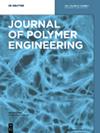Effect of hydroxy-terminated hyperbranched polymer coated separator on the lithium-ion battery performances
IF 1.7
4区 工程技术
Q4 POLYMER SCIENCE
引用次数: 0
Abstract
The hydrophobicity of polyolefin separators causes poor compatibility with the internal environment of lithium-ion batteries and thus elevates lithium-ion migration barriers. In this research, hydroxy-terminated hyperbranched polymer (HTHP) coated separators are fabricated successfully based on the simple and easy-on impregnation method. Abundant hydroxyl groups in HTHP reinforce separator electrolyte affinity, generating the much lower contact angle and higher electrolyte uptake. Accordingly, HTHP-coated separators show broader electrochemical window and superior ionic conductivity and Li羟基端超支化聚合物涂层隔膜对锂离子电池性能的影响
聚烯烃隔膜的疏水性导致其与锂离子电池内部环境的兼容性较差,从而提高了锂离子迁移障碍。本研究采用简单易行的浸渍法成功制备了羟基封端超支化聚合物(HTHP)涂层隔膜。HTHP 中丰富的羟基增强了分离器对电解质的亲和力,使其具有更低的接触角和更高的电解质吸收率。因此,HTHP 涂层隔膜具有更宽的电化学窗口、更高的离子电导率和 Li+ 传输数,这有利于 Li+ 在多孔通道内迁移,从而最大程度地削弱了反离子引起的极化。较低的界面电阻也保证了 Li+ 通过隔膜-电极界面加速扩散。因此,含有改性隔膜的电池具有最佳的 C 率容量和循环稳定性。然而,过量的 HTHP 涂层会堵塞部分孔隙,从而限制 Li+ 的传输,进而降低 C 率容量和循环耐久性。这种隔膜改性方案具有制备简单、环境友好、制造成本低等优点,为低成本、高性能隔膜的制造提供了实用指导。
本文章由计算机程序翻译,如有差异,请以英文原文为准。
求助全文
约1分钟内获得全文
求助全文
来源期刊

Journal of Polymer Engineering
工程技术-高分子科学
CiteScore
3.20
自引率
5.00%
发文量
95
审稿时长
2.5 months
期刊介绍:
Journal of Polymer Engineering publishes reviews, original basic and applied research contributions as well as recent technological developments in polymer engineering. Polymer engineering is a strongly interdisciplinary field and papers published by the journal may span areas such as polymer physics, polymer processing and engineering of polymer-based materials and their applications. The editors and the publisher are committed to high quality standards and rapid handling of the peer review and publication processes.
 求助内容:
求助内容: 应助结果提醒方式:
应助结果提醒方式:


